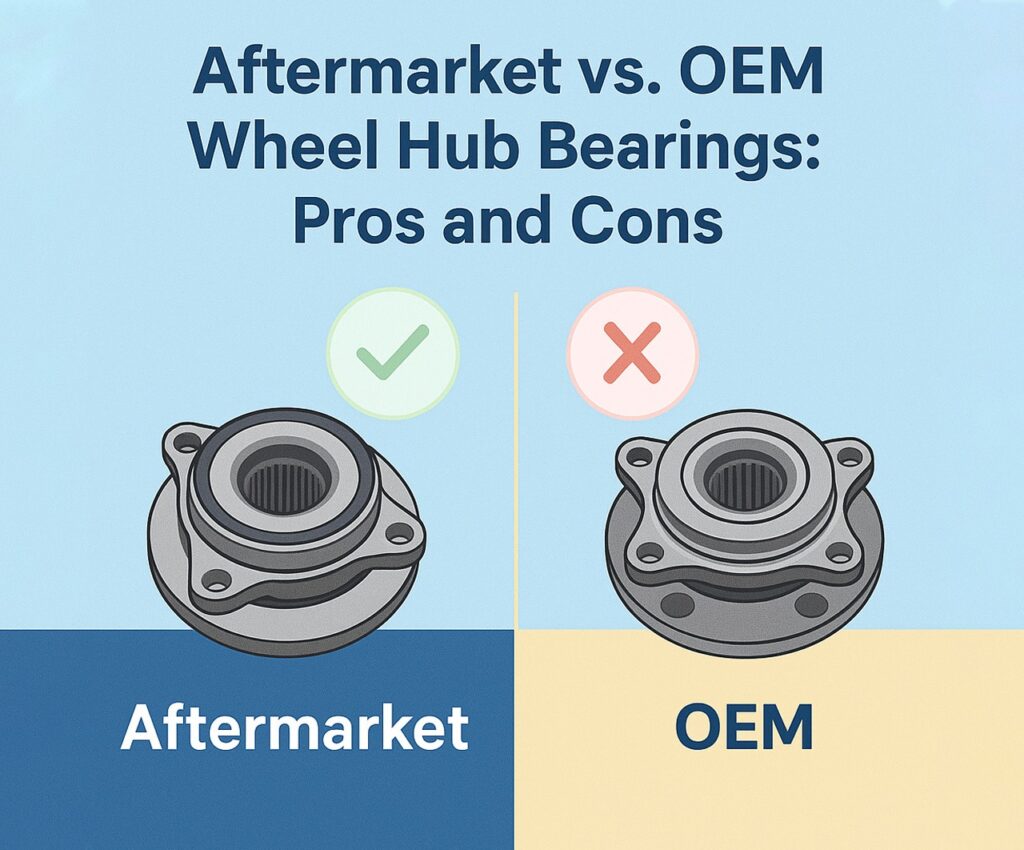When it comes to replacing or upgrading a hub for wheel, especially in towing and heavy-duty applications, buyers are often faced with a decision: go with aftermarket parts or stick to OEM options. Whether you’re fixing a trailer, upgrading a trailer wheel hub, or installing a new trailer wheel hub assembly, understanding the trade-offs between aftermarket and OEM bearings can save time, money, and future hassle. This article breaks down the pros and cons of both choices with a focus on performance, reliability, and cost. Know More
What Are OEM and Aftermarket Wheel Hub Bearings?
OEM (Original Equipment Manufacturer) parts are produced by the same company that supplied the parts for the vehicle or trailer when it was originally built. These components are designed to match the manufacturer’s specifications exactly.
Aftermarket parts, on the other hand, are made by third-party manufacturers. These companies reverse-engineer OEM parts or innovate on them to offer alternatives. Some are built to match OEM specs, while others offer performance upgrades or cost reductions.
Both OEM and aftermarket options are available for every kind of hub for wheel, from passenger vehicles to specialty trailer wheel hub designs.
Pros and Cons of OEM Wheel Hub Bearings
Pros:
- Perfect Fit and Compatibility: OEM parts are designed to match the exact dimensions and tolerances required for your application.
- Predictable Quality: With OEM, you’re getting the same part used in the original vehicle. This ensures consistency.
- Warranty Backing: OEM bearings often come with warranties backed by the vehicle or trailer manufacturer.
Cons:
- Higher Cost: OEM parts are typically more expensive due to brand premiums and dealership markup.
- Limited Innovation: OEM hubs might not feature the latest materials or technologies found in performance aftermarket parts.
- Availability: Depending on your make or model, OEM parts may be harder to find or have longer lead times.
OEM is often the go-to choice for people who want plug-and-play simplicity with the assurance of factory compatibility, particularly for critical assemblies like a trailer wheel hub assembly that supports high-speed towing.
Pros and Cons of Aftermarket Wheel Hub Bearings
Pros:
- Cost Efficiency: Aftermarket bearings are usually more affordable. This is a major draw for fleet operators and budget-conscious consumers.
- More Options: There’s a huge variety of materials and designs to choose from, especially if you’re upgrading a trailer wheel hub for off-road or heavy-duty use.
- Advanced Technology: Some aftermarket products feature upgraded seals, better heat resistance, or even improved corrosion protection.
Cons:
- Variable Quality: Not all aftermarket parts meet the same standards. Some may wear out faster or fit poorly.
- Inconsistent Warranty Support: Coverage can vary drastically between manufacturers.
- Installation Complexity: Some aftermarket bearings require modifications or lack clear installation instructions.
That said, premium aftermarket hubs—particularly in trailer applications—can offer better longevity than OEM if chosen carefully.
Factors to Consider When Choosing Between Aftermarket and OEM
1. Application Type
Is this for a daily commuter or a long-haul trailer? A lightweight hub for wheel on a personal vehicle has different demands compared to a high-load trailer wheel hub assembly pulling thousands of pounds.
2. Cost vs. Value
Calculate the total value: not just the part price, but the cost of installation, expected lifespan, and risk of failure. Sometimes a low-cost aftermarket part ends up costing more over time.
3. Warranty and Support
If you’re running a fleet or commercial setup, a reliable warranty can make all the difference. OEMs often win here, but some aftermarket brands offer solid protection.
4. Availability and Lead Time
In urgent repair scenarios, waiting for an OEM trailer wheel hub might not be viable. Aftermarket suppliers often have better stock or faster shipping.
Real-World Use Cases
- OEM in Commercial Trailers: Companies that manage logistics fleets tend to stick with OEM trailer wheel hub assembly components because downtime is expensive, and compatibility matters.
- Aftermarket for Off-Road Enthusiasts: Off-roaders and DIYers often choose aftermarket parts for their hub for wheel upgrades. They look for better sealing, stronger materials, or custom features.
- Mixed Use in Farming Equipment: Many agricultural trailers use a mix—OEM for the main hubs and aftermarket for replacements that are easier to access and less costly.
Signs of a Quality Aftermarket Hub
Not all aftermarket products are created equal. Here’s what to look for:
- ISO or SAE Certification: These indicate adherence to international standards.
- Material Specs: Look for high-grade steel or corrosion-resistant coatings.
- Brand Reputation: Read reviews and check how long the brand has been in the industry.
- Detailed Specs and Instructions: A quality trailer wheel hub should come with full documentation.
Avoid vague listings or suppliers that don’t clearly state compatibility with your existing trailer wheel hub assembly.
Installation Tips
- Always inspect old parts for wear patterns to identify underlying issues.
- Use a torque wrench to secure your new hub for wheel properly.
- Replace all related components (seals, bolts, grease) during installation.
- After the first 100 miles, recheck the assembly for any looseness or vibration.
Conclusion: Which One Is Right for You?
There’s no universal winner—OEM and aftermarket both have their place. If you want guaranteed compatibility and minimal hassle, OEM is the safe bet. If you’re looking for savings, customization, or advanced performance in your trailer wheel hub setup, high-quality aftermarket options can be a smart move.
Whichever route you choose, make sure the hub for wheel, trailer wheel hub, or trailer wheel hub assembly is from a trusted supplier. Check reviews, compare specifications, and don’t sacrifice safety for short-term savings.
In the end, the best bearing is the one that gets the job done reliably, whether it comes from an OEM catalog or an aftermarket innovator.

